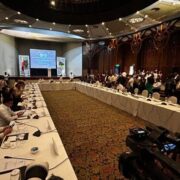Dire situation at top science school

The House of Representatives last week voted to pass on third and final reading a bill that seeks to expand the number of schools under the Philippine Science High School System (PSHS), an urgent measure that should breeze through the notoriously snail-paced legislative process to immediately become law.
Earlier, the Senate approved on second reading Senate Bill No. 2974 or the Expanded Philippine Science High School System Act for a “unified commitment to fostering scientific talent and innovation in the country.”
Unfortunately, the fate of these bills is uncertain with lawmakers distracted by the upcoming midterm elections and the impeachment of Vice President Sara Duterte.
Nevertheless, these actions fan fervent hopes that the law will be passed sooner than later, paving the way for the expansion of the PSHS system under the Department of Science and Technology from the current 16 campuses, so that there will be a maximum of two in every region except in the National Capital Region where the main campus is located.
Suggested sites for new PSHS campuses include Negros Island, Ilocos Norte, Cagayan Province, Aklan, Albay, Bohol, Zamboanga del Sur, Bukidnon, and South Cotabato, in keeping with the authors’ intention to bring world-class science and technology-centered education closer to qualified and deserving Filipino students across the country who will make up the country’s future brain trust.
Brilliant minds
As Speaker Ferdinand Martin Romualdez said, modernizing the 1963 law that established PSHS by expanding the system across the archipelago would provide the Philippines “with a steady supply of brilliant minds.”
More students demonstrating high aptitude for science and mathematics will be taken in, and who can be expected later on to contribute to making the Philippines a hub for development and innovation with its relatively young population.
Expanding the PSHS has become paramount and urgent following reports that the institution has been forced to turn away students equipped to handle the rigor of its intensive curriculum geared toward science and technology excellence simply because there are not enough slots to accommodate them.
According to the Year Two report of the Second Congressional Commission on Education (Edcom II), a body tasked to oversee the country’s education system, each regional campus of the PSHS system can accept only between 90 and 120 students, while the main Quezon City campus can take in 240 students.
Golden opportunity
This is far too small a number considering that some 49,481 applied for school years 2022-2023 and 2024-2025. Of these, 11,351 or 23 percent were “qualified” to enter, but just about half or 5,544 would eventually be accepted.
The remaining 5,807 had to be “turned away,” mainly because of the lack of slots, denying these deserving students with the golden opportunity to enter the country’s top science high school.
Because of the limited slots, qualified applicants have “no opportunity” to enter the PSHS system at all, thus the clarion call by Edcom II to expand the system to increase the number of students supported by scholarships to the country’s top science high school.
Indeed, the dire situation of PSHS must not be allowed to continue, given the massive disruptions in business models across industries following the rise of new technologies such as artificial intelligence that will have corresponding consequences on the country’s labor market and economy.
The Philippine Institute for Development Studies (PIDS), in a 2020 study, said developing technological innovations and development of human resources in science and technology must be at the top of the country’s socioeconomic agenda, adding that the public and private sectors must work to support S&T disciplines.
Driving force
Fortunately, private firms have long been doing their part to grow the pool of future scientists and engineers, for instance the Gokongwei Brothers Foundation, which is among the biggest investors in science, technology, engineering, and mathematics (STEM) education with 1,841 STEM scholars to date.
The Gokongwei family believes that “STEM education is a driving force in sustainable national development, the steppingstone to success for many Filipinos, and the path to industrialization for the country as a whole.”
But much more have to be supported and quickly as based on the latest data from the United Nations Educational, Scientific and Cultural Organization Institute for Statistics, there are only 186 researchers per million inhabitants in the Philippines, one of the lowest among Southeast Asian countries. To compare, Thailand and Malaysia have 963 and 2,054 researchers per million inhabitants, respectively.
The urgency therefore of starting young with the expansion of the PSHS system cannot be overemphasized. Indeed, passing the enabling law is a matter of not just investing in the science education program, but investing in the country’s future.

















